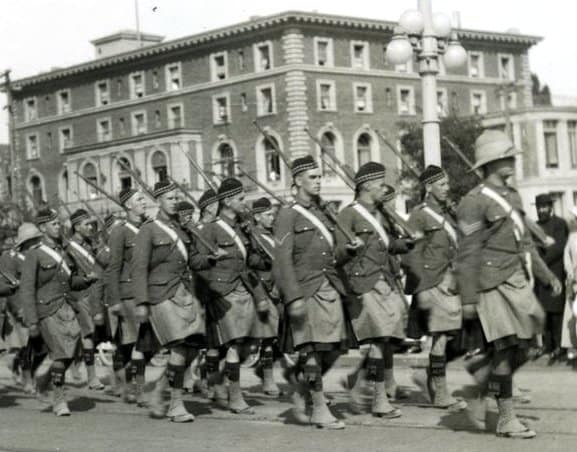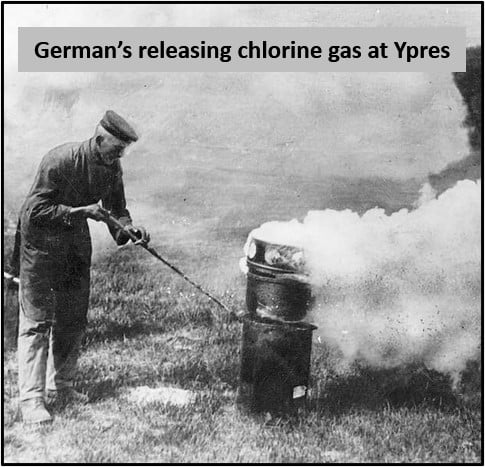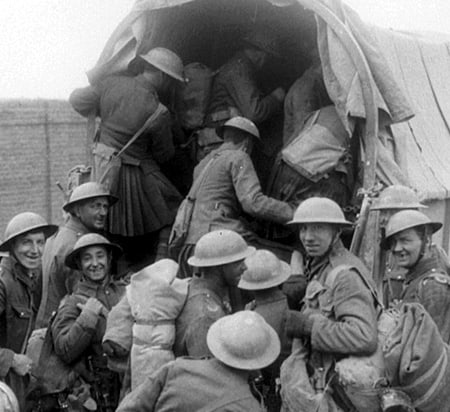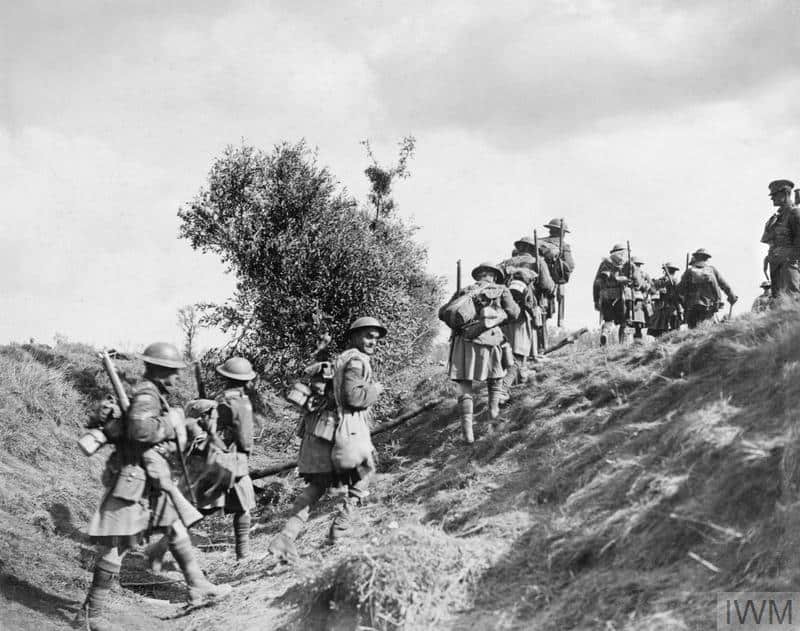History
First World War
Overview
The 16 Battalion (Canadian Scottish) was awarded 23 battle honours during the First World War. The map shows the areas where these honours were awarded. This page of the website will provide a general description of these groups of battles by year with a list the individual battle honours. Sources of detailed descriptions of the battles can be found in the Learning page on this site.
An engagement in Kitcheners Wood, an oak plantation, while deemed not big enough to be classed as a “battle,” was essential to preventing a German breakthrough. The two battalions involved—the 16th Canadian Scottish and the 10th Calgary Highlanders—were awarded the distinction of wearing the Oak Leaf shoulder badge.
1914: Mobilization
When Britain declared war on Germany on 4 August 1914, both of Victoria’s militia regiments were activated for local protective duties. The 88th Fusiliers and the 50th Gordon Highlanders contributed soldiers to the first contingent of the Canadian Expeditionary Force (CEF). With the creation of the CEF numbered battalion system, the 50th Gordons were combined with the three other kilted regiments—the Seaforth Highlanders (Vancouver, BC), the Cameron Highlanders (Winnipeg, Manitoba), and the Argyll and Sutherland Highlanders (Hamilton, Ontario)—to form the 16th Battalion, Canadian Scottish, CEF. After a hard winter training on the Salisbury Plain, the 16th Bttn. left England and arrived in France on 14 February 1915. They would soon enter the fray.
1915: Second Ypres
On the 22nd April 1915, the German Army launched a major attack on the Ypres salient. Their goal was a major breakthrough and to help achieve their objective, they unleashed the first poison gas attack of the war. This caused major breaks in the allied lines, which Canadian troops were able to fill and prevent the breakthrough. The counter attack on Kitcheners Wood by the Canadian Scottish and Calgary Highlanders was instrumental in preventing the breakthrough.
Battle Honours in this sector: Second Battle of Ypres, Gravenstafel Ridge, St. Julien, Battle of Festubert, Givenchy, Battle of Mount Sorrel (June 1916).
1916: Somme
The Battle of the Somme was an attempt to relieve pressure on the French fighting at Verdun. The battle lasted for four months and on the opening day—1 July 1916—approximately 57,000 Commonwealth troops were killed including most of the Royal Newfoundland Regiment. The series of battles ended in a stalemate.
After fighting in several battles, the 16th Battalion was involved in the Battle of Ancre Heights at Regina Trench. They were pinned down by barbed wire and intense enemy fire when Piper James Richardson began playing his pipes and marching in front of his comrades. This inspired them to continue and successfully complete the attack. Richardson died on the battlefield and was posthumously awarded the Victoria Cross. Piper Richardson’s pipes are now on display in the museum.
Battle Honours: Battle of the Somme, Posieres, Thiepval Ridge, Ancre Heights (Regina Trench).
1917: Vimy
Vimy Ridge—which was part of the greater Battle of Arras)—is the best known of the CEF’s engagements during the Great War. Through lessons learned from past failed attacks and effective planning, the Canadian Corps was able to take the ridge and hold of several counter attacks. While preparing for the attack, the 16th and other battalions were secreted in chalk caves where solders carved insignia into the walls. Replicas of the 16th Bttn. crests are on display in the museum.
On 9 April 1917, Private William Johnstone Milne single-handedly took out two machine gun nests saving the lives of many comrades and allowing the attack to advance. Milne went missing later in the battle and his remains were never found. He is commemorated on the Vimy Memorial.
Battle Honours 1917: Battle of Arras, Vimy Ridge, Arleux, Scarpe, Givenchy, Hill 70, Passchendaele.
1918: The Last 100 Days
The Arras and the other battles during the last 100 days advance to victory were “among the most costly but impressive engagements fought by the Canadian Corps during the First World War.” (Canadian War Museum)
Two members of the 16th Battalion were awarded the Victoria Cross for their action at the Drocourt-Queant Line on the 2nd September 1918. Lance-Corporal William Henry Metcalf, carrying a signal flag, walked in front of a tank directing it along the trench in a hail of bullets and bombs allowing the tank to take out enemy strongpoints. Lt. Col, Cyrus Wesley Peck twice went forward under heavy enemy fire to direct the tanks and soldiers with directions that allowed the battalion to push forward.
1918 Battle Honours: Battle of Amiens, Drocourt-Queant, Hindenburg Line, Canal du Nord, Pursuit to Mons, France and Flanders 1915-1918
Demobilization and Perpetuation
Moving CEF soldiers back to Canada for demobilization was a huge logistical challenge with over 260,000 soldiers and an estimated 54,000 dependents needing to be returned. There was ship space for up to 50,000 per month, but passenger rail capacity back in Canada was only about 25,000. Most Western Canadian soldiers went to Winnipeg by train where they were demobilized and given a train ticket to their home city.
With demobilization came the disbanding of the CEF battalions. In 1920, when the Canadian Scottish Regiment was created by the amalgamation of the 88th Fusiliers and the 50th Gordon Highlanders, a system of perpetuation was created where every CEF battalions name would be attached to an existing military regiment. The Canadian Scottish Regiment perpetuated the two founding regiment and the following CEF battalions: 16th Battalion (Canadian Scottish); 48th Battalion (British Columbia) later 3rd Pioneer Battalion; 67th Battalion (Western Scots); 88th Battalion (Victoria Fusiliers); 103rd Battalion; 143 Battalion (BC Bantams).
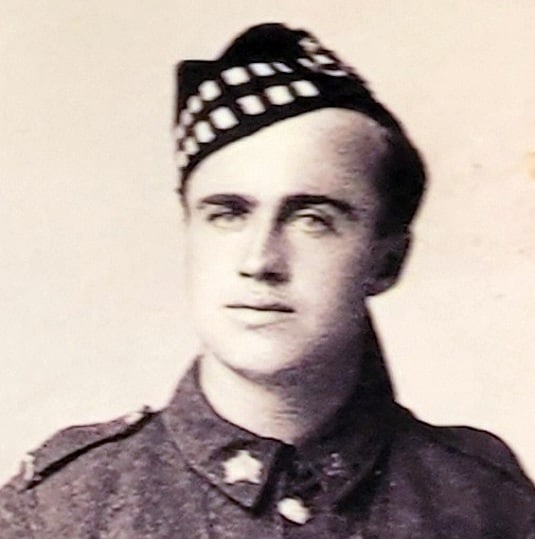
People in Focus
Norman Francis Mairs
MM and Bar
Mairs was a “timberman” from Uxbridge, Ontario who signed up in Victoria in November 1914 and was assigned to the 16th Battalion. He was wounded three times including being buried alive. Mairs was awarded the Military Medal in 1916 for conspicuous bravery for assisting in the dressing of the wounded despite suffering intensely from a severe face wound and losing one eye. He was awarded the MM a second time (Bar) in May 1918.
Mairs was killed in action while attacking an enemy strong post on 8 August 1918. He is buried at Demuin British Cemetery near Amiens, France.



